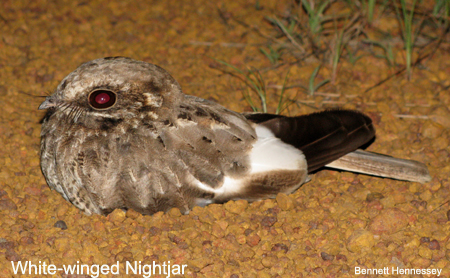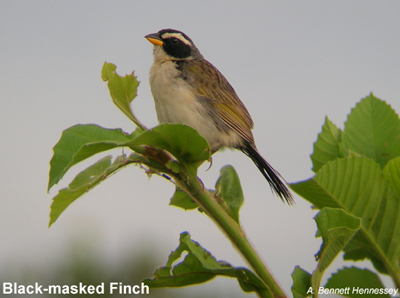Beni Biological Station
by Jon Hornbuckle, Lawrence
Rubey and Bennett Hennessey
 El Porvenir is the entrance and
lodging for the Beni Biological Station, some
50 km east of San
Borja (now, more diverse savanna habitat is better protected at Barba Azul Nature Reserve- Bennett). At the lodge one has easy access to pampas, wetland, forest
islands and one trail into the main forest, which is really fairly far from
the main lodge and not easily visited without camping. A visit of 2‑3
days would be sufficient to see most of the main specialties in the pampas
and wetlands. To do justice to the forest birds, an additional 2‑3 days
minimum is needed to walk and camp in the forest. A local guide can be
arranged at El Porvenir and is almost essential in the forest as the trail is
not well marked. The major part of the reserve is inaccessible except by
chartered boat down the Manique River. Unfortunately, this is the only
way to see one of the reserve's star birds, the endemic and poorly‑known
Unicoloured Thrush ‑ only found in the North‑eastern extremity of
the reserve, well down the river (Note- Ross Macloed reviewed these specimens and thinks the thrush appears to be a darker Hauxwell's Thrush- to date, there is no known site for the Unicolored Thrush. Ross suspects the species might not even exist- just a rare hybrid). El Porvenir is the entrance and
lodging for the Beni Biological Station, some
50 km east of San
Borja (now, more diverse savanna habitat is better protected at Barba Azul Nature Reserve- Bennett). At the lodge one has easy access to pampas, wetland, forest
islands and one trail into the main forest, which is really fairly far from
the main lodge and not easily visited without camping. A visit of 2‑3
days would be sufficient to see most of the main specialties in the pampas
and wetlands. To do justice to the forest birds, an additional 2‑3 days
minimum is needed to walk and camp in the forest. A local guide can be
arranged at El Porvenir and is almost essential in the forest as the trail is
not well marked. The major part of the reserve is inaccessible except by
chartered boat down the Manique River. Unfortunately, this is the only
way to see one of the reserve's star birds, the endemic and poorly‑known
Unicoloured Thrush ‑ only found in the North‑eastern extremity of
the reserve, well down the river (Note- Ross Macloed reviewed these specimens and thinks the thrush appears to be a darker Hauxwell's Thrush- to date, there is no known site for the Unicolored Thrush. Ross suspects the species might not even exist- just a rare hybrid).
The Beni Biological Station is the one in four sites in the world known for the White-winged Nightjar (2 in Paraguay, 1 in Brazil, and 1 in Bolivia). The species has been seen at night on termite mounds near the lodge.
A major macaw roost is located in
the palm trees at El Porvenir ‑
mainly of Chestnut‑fronted
but with a few Golden‑collared. Other birds to look out for around the
headquarters are Dark‑throated and Grey‑and‑chestnut
Seedeaters, White‑rumped Monjita and White‑eared Puffbird, while
at dusk Nacunda Nighthawk, Parauque and Scissor‑tailed Nighjar are
active. The adjacent pampas holds Small‑billed and Red‑winged
Tinamous and Black‑masked Finch, amongst the commoner pampas species,
and where there are scattered trees, Hudson's Black‑Tyrant, Streamer‑tailed
Tyrant and White  Woodpecker and Toco Toucan. Other scarce birds to look for
in this habitat are Long‑winged Harrier, Ocellated Crake, Aplomado
Falcon, Tawny‑headed Swallow and Sharp‑tailed Tyrant. Woodpecker and Toco Toucan. Other scarce birds to look for
in this habitat are Long‑winged Harrier, Ocellated Crake, Aplomado
Falcon, Tawny‑headed Swallow and Sharp‑tailed Tyrant.
The margins of the larger forest
islands are the best localities for White‑wedged Piculet, Rufous‑breasted
Hermit and flycatchers such as Swainson's and Short‑crested, Large,
Small‑billed, Lesser and Yellow‑bellied Elaenias and Plain and
Grey‑crowned / White‑crested (ref) Tyrannulets, and the skulking
spinetails ‑ Pale‑breasted and Cinereous‑breasted. The
larger islands hold Tropical Screech‑Owl, Plush‑crested Jay and
Epaulet Oriole.
Early morning at Laguna Normandia,
a
3 km
walk from El Porvenir, should be rewarded by a variety of water birds
including storks, ibises and Rufous‑sided and Ash‑throated
Crakes, while Yellow‑chinned Spinetail, Unicoloured and Scarlet‑headed
Blackbirds, White‑bellied Seedeater and Crested Doradito are amongst
the inhabitants of the swampy vegetation. The rare Black Caiman has been
introduced and thrives in the laguna, as do Pirhana ‑ good
reasons for not taking a swim! A couple of hours or more on the boardwalk
should produce species such as Striped Cuckoo, White‑tailed
Goldenthroat, White‑headed Marsh‑ and Yellow‑browed Tyrants
and possibly Long‑tailed Reed‑Finch and Tawny‑bellied
Seedeater, or even a rarity such as Least Bittern or Black / Great‑billed
Seed‑Finch.
From here one can head south along
the fringe of the laguna to the scrubby edge of the large forest fragment,
Florida. This is also a good locality for flycatchers and seedeaters, and the
only regular site for Thick‑billed Euphonia. It is easy to get lost in
Florida, as there are no trails, so be sure to take a compass. The forest is
badly degraded, mainly by cattle but the damp western end holds a surprising
number of birds, eg Slate‑coloured Hawk, Sunbittern, Green‑and‑rufous
and Pygmy Kingfishers, Lettered Aracari, Black‑ fronted Nunbird, White‑throated
and Cream‑coloured Woodpeckers, Bolivian Slaty Antshrike, Band‑tailed
Manakin, Rusty‑fronted Tody‑Flycatcher and even Boat‑billed
Heron.
A visit to the laguna in late
afternoon can also be worthwhile, as many birds fly past to roost. Spot‑tailed
Nightjars start hunting as the last light fades. The first Rufous‑faced
Crake for Bolivia was caught here but sightings have only come from a marshy
area to the northeast, where Bolivia's first Speckled Crake was also flushed.
To reach continuous forest it is necessary to walk
7 km to Trapiche where there
is a good camp‑site just inside the riverine (seasonally inundated)
forest, dominated by palms. The route passes through chaco‑like habitat
where birds such as Narrow‑billed Woodcreeper, Pearly‑vented Tody‑Tyrant,
White‑bellied Tyrannulet, Red‑crested Finch and even Xenopsaris
have been seen, while at night both Grey and Great Potoos and Little and
Scissor‑tailed Nightjars can be spot‑lighted. From Trapiche you can
walk further in to the terra firme forest and on to Pascana camp‑site,
either as a day trip or to camp there. Both Sunbittern and the rarer Sungrebe
should be looked for at the river crossing. Pascana is the end of the easy
trail but several days could be profitably spent here exploring the higher
and denser, swamp‑forest surrounding the black water lagoon. If time is
short, the walk back to the lodge can be accomplished in a day.
Note from Bennett: The Beni
Biological Station receives few guests presently. We do not know how prepared
they are to receive tourists. We don't recommend just showing up there, but
we also can't find contact information. Send a note to Bird Bolivia
(birdbolivia@unete.com) if you would like more information.
Access and accommodation
As of April 2010, we are unfamiliar with the present state of the Station- and whether in fact it is open. We don't have contact information here, sorry. We suggest reviewing protected savannas (without cattle or burning) at the Barba Azul Nature Reserve. El Porvenir is some two hours from
San Borja. There are presently changing a weekly flight to San Borja from
La Paz and
Trinidad. There are also buses from La Paz, Trinidad and Rurrenabaque. Good
meals and accommodation are available at El Porvenir, at a cost of $25‑30?
a day full board.
GPS reading at EBB:
S 14 52.219 W 66 19.558 |

